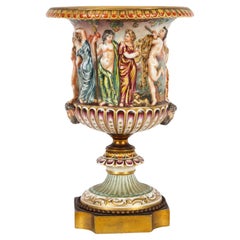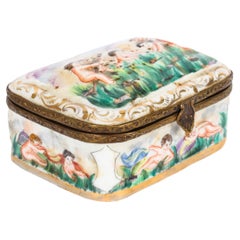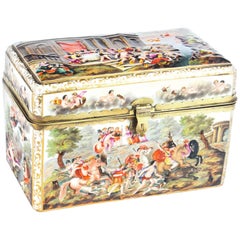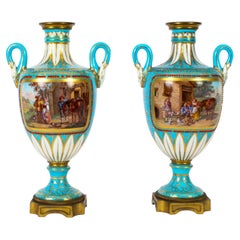Want more images or videos?
Request additional images or videos from the seller
1 of 9
Antique Pair of Capodimonte Porcelain Urns Vases Jars, circa 1900
Price:$224.72
About the Item
- Dimensions:Height: 4.73 in (12 cm)Width: 3.55 in (9 cm)Depth: 3.55 in (9 cm)
- Sold As:Set of 2
- Materials and Techniques:
- Place of Origin:
- Period:1900-1909
- Date of Manufacture:circa 1900
- Condition:
- Seller Location:London, GB
- Reference Number:Seller: 08402a1stDibs: LU95068665833
About the Seller
5.0
Platinum Seller
Premium sellers with a 4.7+ rating and 24-hour response times
Established in 1983
1stDibs seller since 2012
1,406 sales on 1stDibs
Associations
LAPADA - The Association of Arts & Antiques Dealers
Authenticity Guarantee
In the unlikely event there’s an issue with an item’s authenticity, contact us within 1 year for a full refund. DetailsMoney-Back Guarantee
If your item is not as described, is damaged in transit, or does not arrive, contact us within 7 days for a full refund. Details24-Hour Cancellation
You have a 24-hour grace period in which to reconsider your purchase, with no questions asked.Vetted Professional Sellers
Our world-class sellers must adhere to strict standards for service and quality, maintaining the integrity of our listings.Price-Match Guarantee
If you find that a seller listed the same item for a lower price elsewhere, we’ll match it.Trusted Global Delivery
Our best-in-class carrier network provides specialized shipping options worldwide, including custom delivery.You May Also Like
20th Century Porcelain Capodimonte Ornamental Urn or Jar
By Capo Di Monte
Located in Miami, FL
20th century porcelain Capodimonte ornamental urn or jar.
Category
Early 20th Century Italian Neoclassical Porcelain
Materials
Ceramic
Pair of Porcelain Urns, Empire circa 1800
Located in Stockholm, SE
A pair of porcelain urns from the empire period, probably Russian. Painted with flowers and gilded.
Category
Antique Early 19th Century European Empire Porcelain
Materials
Porcelain
$3,235 Sale Price / set
35% Off
H 16.54 in W 7.88 in D 6.3 in
Large Pair of Magenta Ground Vienna Porcelain Exhibition Vases, circa 1900
By Royal Vienna Porcelain
Located in Brighton, West Sussex
An important and extremely large pair of Magenta Ground Vienna Porcelain Exhibition vases.
Austrian, circa 1900.
Each vase with blue underglazed ‘Beehive’ mark to interior of neck.
Each vase is finely painted with classical scenes to the front and allegorical scenes to the back on a rich magenta ground with gilt foliate decoration. The vases are mounted by extraordinary gilt handles headed by winged female masks to the sides and grotesque masks to the shoulders. The spreading necks decorated with Greek key decoration are surmounted by domed covers and the vases are raised on baluster form supports put down on drum bases finely painted with panels stylised arabesque.
The Vienna Porcelain Manufactory was founded in 1718 only eight years after Johann Friedrich Bottger and Ehrenfried Walther von Tschirnhaus had succeeded in unearthing the secret of Porcelain Manufacture for August the Strong, Elector of Saxony. On May 25, 1718, Emperor Karl VI signed a "special privilege" awarding Claudius Innocentius du Paquier the exclusive right to produce porcelain in the Austrian crown lands. Production being almost exclusively for the imperial household and the court nobility.
During the rococo era, Empress Maria Theresia placed the company under imperial ownership and it was during this period that the manufactory began to produce the famous rococo genre scenes after Watteau. Under the management of Conrad Sorgel von Sorgenthal, the Vienna Porcelain Manufactory achieved an international reputation for its neo-classical style.
After the wars with France brought the manufactory to the brink of ruin, the Vienna Congress at the beginning of the Nineteenth Century gave porcelain from Vienna a renewed upswing. Many important personalities of the time, including Czar Alexander I of Russia...
Category
Antique Late 19th Century Austrian Vases
Materials
Porcelain
$129,385 / set
H 57.09 in W 22.45 in D 15.75 in
Circa 1800 Pair of Floral Paris Porcelain Urns
Located in Scottsdale, AZ
Circa 1800 Pair of Floral Paris Porcelain Urns
Beautiful pair purchased in France. Age appropriate wear, see detailed photos or message us with questions.
Category
Antique 19th Century French Neoclassical Porcelain
Materials
Porcelain
Pair of 1900's Blue porcelain vases from Tours
By Gustave Asch
Located in Paris, FR
Pair of 1900 vases in blue porcelain of Tours with gilded decoration of roses topped by ribbons. These gold-coloured motifs are typical of the Art Nouveau decorations of the ceramist...
Category
Early 20th Century French Art Nouveau Porcelain
Materials
Porcelain
Capodimonte, Italy. Antique porcelain vase with putti in relief. Early 20th C.
Located in København, Copenhagen
Capodimonte, Italy. Antique porcelain vase with putti in relief and hand-painted gold decoration.
Early 20th century.
Measures: 18 x 13.5 cm...
Category
Early 20th Century Italian Vases
Materials
Porcelain
$320 Sale Price
20% Off
H 7.09 in Dm 5.12 in
Antique Capodimonte Porcelain Table Snuff or Dresser Box
By Capodimonte
Located in Philadelphia, PA
A fine, antique Capodimonte porcelain table snuff box in the Meissen style.
With a polychrome enamel Bacchanalian scene on the lid, neoclassical...
Category
Early 20th Century Italian Rococo Revival Porcelain
Materials
Porcelain
Large Antique Capodimonte Porcelain Plaque of a Naiad or Water Nymph
By Capodimonte
Located in Philadelphia, PA
A fine and large-scale Capodimonte porcelain plaque depicting a Naiad (or a water nymph from Greek mythology). She is attended by a small ...
Category
Antique Late 19th Century Italian Renaissance Porcelain
Materials
Porcelain
$1,920 Sale Price
20% Off
H 18.5 in W 11.25 in D 2 in
Quality antique Victorian Italian Capodimonte porcelain table casket
Located in Ipswich, GB
Quality antique Victorian Italian Capodimonte porcelain table casket having a quality antique Victorian Capodimonte porcelain table casket with a clasp to the front opening to reveal...
Category
Antique Early 19th Century Italian Victorian Porcelain
Materials
Porcelain
$1,253
Free Shipping
H 3.55 in W 8.27 in D 6.3 in
Pair Antique Imari Porcelain Fluted Design Vases, Circa 1880
Located in New Orleans, LA
Pair antique Imari Porcelain fluted design vases, Circa 1880.
Category
Antique 19th Century Asian Ceramics
Materials
Porcelain
More From This Seller
View AllAntique Italian Naples Capodimonte Urn 19th Century
Located in London, GB
This is a beautiful antique Italian Naples Capodimonte porcelain urn, late 19th Century in date and bearing the Naples Capodimonte blue painted crown s...
Category
Antique 1890s Italian Porcelain
Materials
Porcelain
Antique Italian Capodimonte Porcelain Table 19th Century
Located in London, GB
This is a beautiful antique Italian Capodimonte porcelain casket, late 19th Century in date.
The box and cover are superbly decorated in relief with classical scenes, and there are...
Category
Antique 1890s Italian Porcelain
Materials
Porcelain
Antique Italian Capodimonte Porcelain Table Casket, 19th Century
Located in London, GB
This is a beautiful antique large Italian Capodimonte porcelain table casket, 1880 in date.
It features a gladiatorial scene with the Emperor and Empr...
Category
Antique 1880s Italian Porcelain
Materials
Ormolu
Antique Pair of French Bleu Celeste Porcelain Urns 19th Century
Located in London, GB
This is a fine and rare antique pair of French porcelain ormolu mounted twin handled urns in the Sevres manner, dating from Circa 1860.
The decorative twin handle vases are super...
Category
Antique 1860s French Porcelain
Materials
Ormolu
Antique Pair Dresden Lidded Porcelain Vases & Covers Early 20th Century
Located in London, GB
This is a beautiful pair of Dresden lidded vases and covers, circa 1900 in date.
Superbly painted with panels of figural scenes of courting couples and flowers on a yellow and gilt ground, with underglaze blue Dresden marks to the bases.
They are beautiful objects which will look fabulous in most surroundings.
Condition:
In excellent condition with no chips, cracks or signs of repair, and only very minor signs of wear comensurate with age and use, please see photos for confirmation of condition.
Dimensions in cm:
Height 32 x Width 20 x Depth 20
Dimensions in inches:
Height 1 foot, 1 inch x Width 8 inches x Depth 8 inches
Dresden porcelain - A King's Obsession
In the early 1700s, King Augustus II, prince elector of Saxony, held goldsmith Johann Bottger prisoner and commissioned him to create gold. Bottger instead discovered the method of creating porcelain, a favored and valuable item in the king's eyes.
The king announced to Europe in 1710 that he would open a porcelain manufactory in Dresden. He instead opened one at nearby Albrechtsburg castle. Espionage was rampant, and the king guarded his porcelain secret, even though it meant imprisoning workers within the castle walls.
By 1720, the secret was leaked and porcelain producers popped up in Vienna and Venice. Dresden porcelain adopted Saxon crossed swords in under-glaze blue as its distinguishing mark.
In 1736, the porcelain manufactory produced the "Swan Service...
Category
Antique Early 1900s German Porcelain
Materials
Porcelain
Antique Pair Dresden Porcelain Pot Pourri Lidded Vases 1920s 20th C
Located in London, GB
This is a beautiful antique pair of fine quality Dresden porcelain pot pourri urns and covers, circa 1920 in date.
Each painted with harbour scenes on a patterned ground and bearing underglaze blue AR marks.
They are beautiful objects which will look fabulous in all surroundings.
Condition:
In really excellent condition with no chips, cracks or signs of repair, and only very minor signs of wear comensurate with age and use, please see photos for confirmation of condition.
Dimensions in cm:
Height 41 x Width 23 x Depth 17
Dimensions in inches:
Height 1 foot, 4 inches x Width 9 inches x Depth 7 inches
Dresden porcelain - A King's Obsession
In the early 1700s, King Augustus II, prince elector of Saxony, held goldsmith Johann Bottger prisoner and commissioned him to create gold. Bottger instead discovered the method of creating porcelain, a favored and valuable item in the king's eyes.
The king announced to Europe in 1710 that he would open a porcelain manufactory in Dresden. He instead opened one at nearby Albrechtsburg castle. Espionage was rampant, and the king guarded his porcelain secret, even though it meant imprisoning workers within the castle walls.
By 1720, the secret was leaked and porcelain producers popped up in Vienna and Venice. Dresden porcelain adopted Saxon crossed swords in under-glaze blue as its distinguishing mark.
In 1736, the porcelain manufactory produced the "Swan Service...
Category
Vintage 1920s Porcelain
Materials
Porcelain
Recently Viewed
View AllMore Ways To Browse
Capodimonte Pair
Capodimonte Urn
Meissen England
Meissen Fish
Meissen Four Seasons
Meissen Musicians
Meissen Peter Strang
Meissen Potpourri
Meissen Red
Meissen Strang
Minton Pate Sur Pate
Monogram Porcelain
Nantgarw Pottery On Sale
Nelson Ceramics
Noritake Hand Painted
Porcelain Chocolate Sets
Purple Herend
Rosenthal Blue And White



